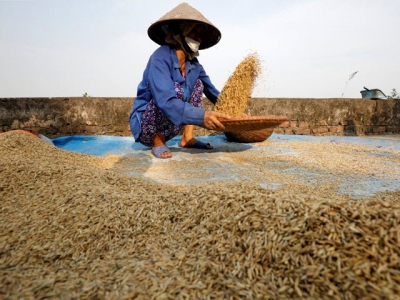Asia Rice-Vietnam struggles to find new buyers as Chinese demand dwindles

Export prices of rice from Vietnam fell this week as the country struggled to find new buyers amid waning demand from China, while a drought continued to squeeze supply in Thailand and a weak rupee weighed on rates for the Indian variety.
A farmer harvests rice by a paddy field outside Hanoi, Vietnam June 10, 2019. Photo: Reuters
Prices for Vietnam’s 5% broken rice fell to $335-$345 a tonne on Thursday from $340-$350 last week.
“Vietnam is struggling to find new markets to compensate for the sharp decline in shipments to China,” a trader based in Ho Chi Minh City said.
Exports to China in the first seven months of this year fell 65.7% from the corresponding period last year, to 318,100 tonnes, Vietnamese customs data showed.
“We heard from Chinese importers that China’s demand for rice remains high but the importers cannot buy from Vietnam because of new technical barriers the Chinese government has imposed,” the trader said.
Vietnam’s Ministry and Industry and Trade said on Wednesday it would organise several trade promotion trips this year to boost rice exports.
Meanwhile, Thailand’s benchmark 5% broken rice prices narrowed to $415-$425 a tonne on Thursday from $406-$425 last week, with traders attributing the relatively high prices to concerns over supply as the country grapples with its worst drought in a decade.
“Domestic prices are up due to fears over possible shortage of rice because of the drought,” a Bangkok based trader said.
African market active
Demand, however, remained relatively flat and the strong baht — Asia’s best performing currency this year — has kept Thai prices higher than those of other Asian hubs.
“It’s hard to find new buyers as the price will likely increase going forward due to the foreign exchange as well as domestic supply situation,” another trader said.
Top exporter India saw prices of its 5% broken parboiled variety ease to about $374-$377 per tonne from last week’s $377-$381.
“Africa market is again active now, said Nitin Gupta, vice president for Olam India’s rice business.
“Due to the currency depreciation in the last couple of days, prices have corrected.”
India’s rice exports in April-June dived 28.2% from a year ago to 2.35 million tonnes, a government body said on Monday, due to subdued demand for non-basmati rice from Africa.
In neighbouring Bangladesh, traders demanded cash incentives for rice exports as the country has been unable to secure any deals since a long-standing ban was lifted in May.
“At present, we’re not in a position to compete with India or Thailand for parboiled rice. It’s almost impossible to export any rice unless the government provides at least 20% cash subsidy on exports,” a Dhaka-based trader said.
Có thể bạn quan tâm
 Vietnam's rice prices suffer fall due to sharp decline in demand from China
Vietnam's rice prices suffer fall due to sharp decline in demand from China Vietnam is facing a number of difficulties in branching out to new markets due to a sharp decline in rice demand from China, according to a trader in HCM City.
 VN agriculture capitalising from private investment
VN agriculture capitalising from private investment Private sector investment has recently surged in the field of agriculture, contributing to building sustainability in the sector across Vietnam.
 Technology application in agriculture strengthened
Technology application in agriculture strengthened The Vietnamese Party and State have in recent years urged the use of technology to boost socio-economic development. Technological advances have been widely